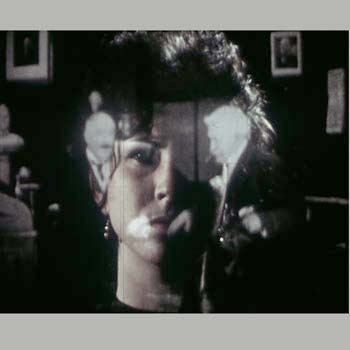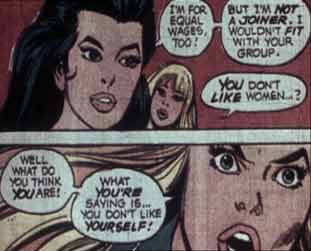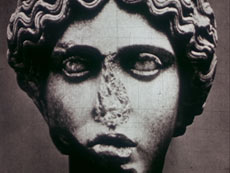From Monthly Film Bulletin, December 1974 (Vol. 41, No. 491).
I must admit that the hyperbole of the last couple of sentences here embarrasses me now. But readers can judge for themselves, because this first feature by Laura Mulvey and Peter Wollen has recently become available as an extra on the BFI DVD of Riddles of the Sphinx. –- J.R.

Great Britain, 1974 Directors: Laura Mulvey, Peter Wollen
The film is composed of five sequences, each preceded by a quotation. 1: “Ghost white like a not yet written page” (Mallarmé, “Mimique” ): A mime of Kleist’s Penthesilea, filmed in long shot from a fixed camera position. 2: “The shadows sprinkled in black characters” (Mallarmé, “Quant au livre”): A lecture on Kleist’s play, the myth of Penthesilea and the theoretical basis of the film, delivered by Peter Wollen while moving about a terrace and adjoining living room, the camera tracing an independent trajectory within the same confined space and occasionally approaching the index cards of notes left behind by Wollen at various stages in his route. 3: “Blazons of phobia, seals of self-punishment” (Lacan, after Vico): A succession of images relating to Penthesilea and the Amazons — paintings, sculptures, artifacts, tapestries, etc., including frames from a Wonder Woman comic book — separated by animated wipes and maskings, and accompanied on the soundtrack by Berio’s “Visage”. 4: “Net of light on overlight” (H.D., “Projector”): A silent film, What 80 Million Women Want (1913), on which a woman’s face in color is superimposed, speaking the words of feminist Jesse Ashley. 5: “Notes on the magic writing pad” (Freud): Four black-and-white television screens simultaneously present The preceding sections of the film; the camera occasionally isolates an individual screen, and similarly the soundtrack occasionally highIights one of the preceding soundtracks; gradually the material on the screens is replaced by new footage of the mime actress portraying Penthesilea returning to her dressing room, taking off her make-up, and addressing the camera.
Fascinating overall for its investigation into alternative didactic methods and the relationship between independently expressive surfaces and texts, Penthesilea is far from simple going when one confronts the opening sequence: too remote from both the mime itself and one’s subsequent perception of the film’s general design, it simply demands more (or less) than one can comfortably bring to it. Once past this obstacle — an interesting and legitimate sequence that acquires interest only after the fact — one is swiftly rewarded by the words and camera movements of sequence #2, which beautifully juggle sound and image, theory and practice, Wollen’s trajectory and the camera’s in something resembling a two-part invention.
Wittiest of all are the cue cards strewn in Wollen’s path, which the camera ‘picks up’ after him like a dutiful servant: sometimes the words on the card duplicate an earlier part of the lecture, sometimes the reflection of light on the cards makes the words paradoxically illegible, and at one strange juncture — properly speaking, the only ‘fictional’ moment in the entire film — the words appear just as they are being spoken in another room. Sequence #3 registers as a systematic exploration into how one can arrive at an order of things (the succession of Wonder Woman frames providing an inventory of ways one image can follow another), while the Berio piece offsets this with what is described.in the Autumn 1974 Screen (an interview with Mulvey and Wollen that usefully supplements the film) as “the ‘birth’ of a new form of language”. #4 juxtaposes two ‘texts’ in the form of superimposed images, with a historical artifact set against a contemporary recitation of a historical document; and #5 exploits some of the Wavelength-like paradoxes of relative illusionist surfaces (as when the camera moves into a TV screen showing sequence #2,where the camera is also moving) while drawing all of the previous juxtapositions and new material into fresh mixtures and relationships. Each sequence, it must be noted, consists of two reels ‘invisibly’ joined (in the manner of Rope), and the justifications for this non-editing are stated succinctly in Wollen’s lecture, which also alludes to “The space between a story that is never told and a history that has never yet been made” — that array of lecture material around an unarticulated story that the film occupies, with speculative past myth and speculative utopian myth developing concurrently from the empty spaces.
Curiously but perhaps inevitably, the film’s conceptual framework somewhat overrides the feminist theme it pursues, and the question of how one perceives Penthesilea becomes somewhat more of a subject than the figure herself. One recalls the structure of Godard’s One Plus One, with its similar notion of grappling with diverse phenomena by placing them side by side (albeit in an edited context), with the Anne Wiazemsky question-and-answer sequence performing an expositional function somewhat analogous to Wollen’s lecture. But One Plus One arguably represented the end of something, while Penthesilea suggests a beginning — a step forward in the European avant-garde that cross-fertilizes more active currents (from the American structural film to Tel Quel) than this review could hope to enumerate. An object for reflection and inquiry more than a ‘finished’ statement, it is a theoretical do-it-yourself kit –- or stated differently, an exploratory tool –- of the first importance.
JONATHAN ROSENBAUM


